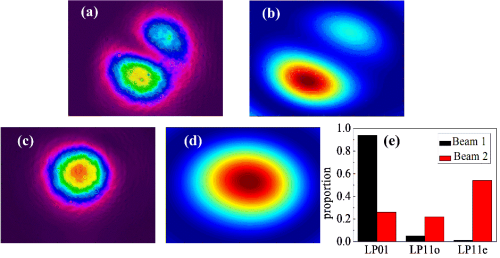Recently, by investigating the high power transverse mode controllable laser system, researchers from Shanghai Institute of Optics and Fine Mechanics, Chinese Academy of Sciences, achieved the 1.4 kW-level fiber laser system with mode control to select LP01 or LP11. The related results are published in the IEEE Journal of Lightwave Technology on Jan. 6, 2021.
High-power fiber lasers based on large mode area (LMA) Yb-doped fiber (YDF) have significant research and application value in various fields due to excellent power conversion efficiency and power stability.
However, since the V-value of LMA-YDF is over 2.4, various transverse modes coexist in the fiber core. Seriously, transverse mode instability (TMI) can occur to limit the power scaling of the fiber laser, resulted from the thermal effect under the conditions of high-power and strong pumping. If different transverse modes in the LMA fiber can be excited individually by the control, not only the TMI can be suppressed, but also single transverse mode or their superposition can be emitted selectively. This can be applied in many special situations.
In their work, researchers coiled the active fiber of the main amplifier to limit the supported modes. The loss of the high order modes is increased except for LP01 and LP11 mode. A 1.4 kW fiber laser is obtained with several modes. Based on the intensity distribution of LP01 and LP11 modes, the central intensity of the output beam is detected and set as the merit function to distinguish the different modes. A high-speed field programmable gate array (FPGA) is used to load the SPGD algorithm and generates 4-channel feedback voltage signals to drive the mode controller.
Consequently, the piezoelectric actuators (PZT) inside the mode controller squeeze the fiber to change the proportion of the transverse modes. When these modes are injected into the main amplifier, selectable transverse modes are excited and scaled individually because of the mode competition of the amplifier. The LP01 mode is generated when the SPGD algorithm searches for the maximum value and the LP11 mode for minimum value. When the optical intensity distribution captured by an infrared camera is deconstructed and analyzed the optical-to-optical efficiency is 85.8% and 84.1% for LP01 and LP11 modes, respectively, in both situations. The conversion efficiency between the two modes reaches 99.5%. To the best of our knowledge, this is the first time to obtain a 1.4 kW level fiber laser with controllable transverse modes. This laser has significant prospects of application such as optical tweezers, atom trapping, and laser micromachining. Moreover, the active mode control technique with wide bandwidth also provides favorable conditions for the investigation of TMI in fiber laser.
This research is supported by the National Natural Science Foundation of China.


Article website:
https://doi.org/10.1109/JLT.2021.3049603
Contact:
WU Xiufeng
General Administrative Office
Shanghai Institute of Optics and Fine Mechanics, CAS
Email: xfwu@siom.ac.cn
Web: http://english.siom.cas.cn/